By Kimberly Marshall, Washingtonville Master Gardener Volunteer
This article appeared in the June 2021 Issue of Gardening in Orange County.
As more of us try to incorporate native plants into our landscapes and home-gardening plans, it’s easy to overlook the benefits of planting native trees. Just like the flowers and shrubs we tend to think about as being great food for pollinators, birds, and other native animals, trees native to our area provide all these benefits too (and more).
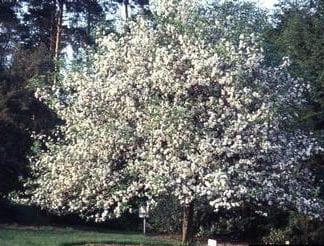
Take, for example, the native sweet crabapple tree, or Malus coronaria (which is part of the Rosaceae family). Other than providing food and nesting areas for native birds, this small- to medium-sized tree (usually around twenty to thirty feet tall, with a broad top) also attracts a number of native bees and feeds other creatures, like turkeys, rabbits, and deer. The tree tends to flower about two weeks later than the domestic apple—generally from March to June—and it holds onto its fruit long after it sheds its leaves, providing food for local critters long into the autumnal season.
The sweet crabapple can be typically identified by its grey- to reddish-brown bark, separated on the surface into scale-like fissures. When fully mature, it’s a bushy shrub with contorted branches that some people say resembles the bonsai tree because of the way the branches tangle and jut out at strange angles.
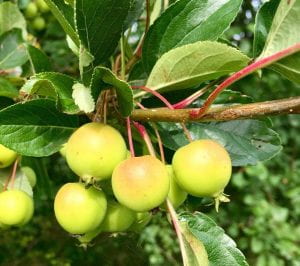
In the spring, the tree puts forth cheerful, rosy-white blooms that can sometimes be more white or pink, depending on the tree. Its fruit, small (about two inches in diameter) and bitter, contains high amounts of malic acid. These crabapples are not usually eaten straight off of the tree, but are cooked and used to make preserves (as they’re naturally full of pectin), apple cider, pies, and vinegar. They can also be buried underground to neutralize their acidity over the winter, or you can sweeten them with sugar. Some people dry the apples over a fire or in the sun, and store them for later use.
Since they are native to our area, it should come as no surprise that these trees were greatly utilized by Native Americans and early English settlers. Since the tree is on the smaller side, the wood—which is heavy and dense, but also close-grained and flexible—was mainly used to craft into handles for tools, for woodcarving, or to burn as fuel for fires. The bark could be used to make a yellow dye, but it was also prized for its medicinal properties. It was used to treat gallstones, sore mouths, malaria, and tuberculosis, among other common ailments.
When these trees grow in the area naturally, they tend to stick to the edges of our forests, open pastures, old fields, and streambanks. And while the tree’s main region is centered in and around the Great Lakes, Malus coronaria also grows in other areas, mainly along the Ohio River Valley, southern Ontario, and several adjacent states.
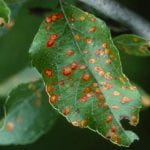
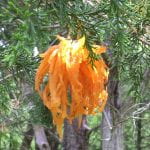
Since these trees are extremely susceptible to rust, it’s recommended that you plant them at least 500 feet from any cedars you might have on your property (especially the Eastern red cedar, Juniperus virginiana), as the proximity of these trees can cause cedar-apple rust to wreak havoc on your crabapples. This is a fungus that needs two hosts—both the apple and the cedar—to grow. On the crabapple, the cedar-apple rust tends to manifest as small, rust-colored spots on the leaves, while the fungus takes an entirely different form on the cedar, growing large, round, and orange, gummy-looking structures that almost look like they’re growing gooey orange tentacles.
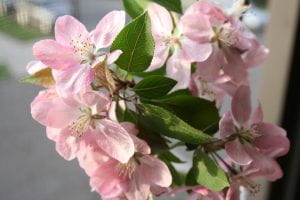
Although the Malus coronaria is a beautiful tree, especially when its fragrant flowers bloom in the spring, many people tend to shy away from this crabapple because of its susceptibility to pests and diseases. But gardeners who do want to grow these trees can do so from seed, which can produce some different-colored flowers. The tree can also be used as rootstock for grafting cultivated apples and is revered for its hardiness.
If you’re interested in growing this ornamental tree, plant it in an area of your yard that has well-drained, loamy soil. It does best in a sunny to partially shaded location. Again, make sure there are no cedars close by, and remember to check often for any signs of disease, such as small rust-colored spots on the leaves or a blackish canker on the bark, stem, or branches. If you find any of these symptoms, you will have to prune the affected areas before the disease spreads to save the tree and treat it appropriately before the disease gets out of control. However, if you’ve given your crabapple tree the proper growing conditions, it should remain relatively pest- and disease-free and bring you many years of enjoyment.
